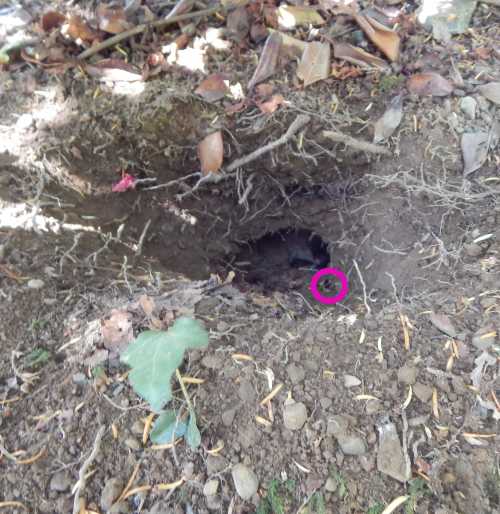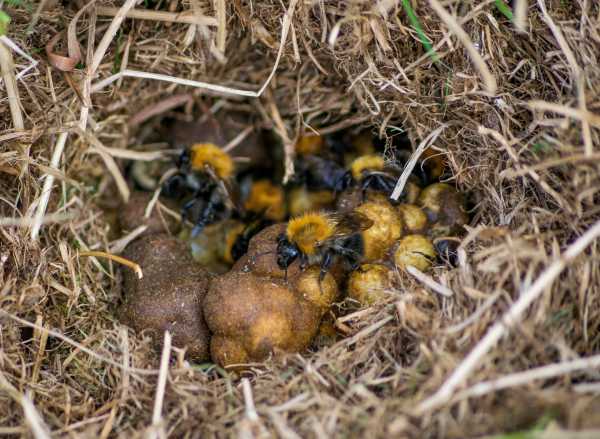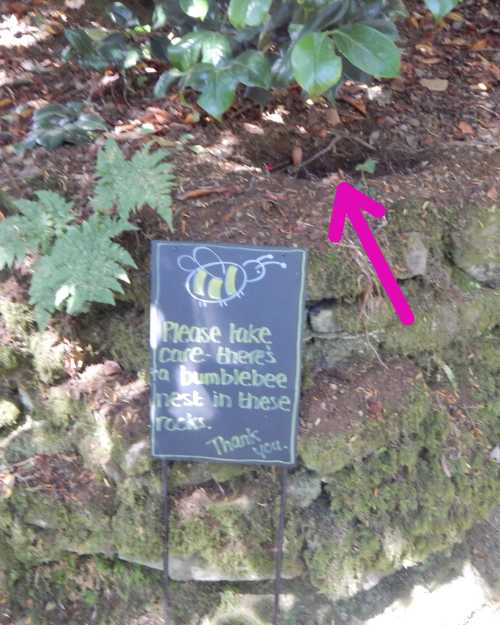Why Do Bumble Bees Nest In The Ground?
Availability of suitable habitat for nest sites in which bumble bees can raise their colonies to secure future generations, is crucial for the survival of bumble bees. Species have differing requirements.
I recently received a query regarding bumble bee nests, and specifically, 'why do bumble bees nest in the ground?'
In fact, not all bumble bee species do nest in the ground. So let's take a look at this question here.
Why Do (Some) Bumble Bees Nest In The Ground?
 Entrance of an underground bumble bee nest
Entrance of an underground bumble bee nestUnderground nests (as opposed to 'surface nests' - i.e. those in more exposed locations) could offer a number of important advantages to bumble bees.
These advantages could be:
1. Significantly reduced exposure to predators
For example, using an abandoned mouse or vole hole would mean a nest is less visible and/or accessible to certain predators, including birds, and some mammals and possibly even other invertebrate predators.
2. Nest defence
Nest defence may be easier when occupying a hole with an entrance, rather than having an open, exposed nest.
3. Shelter
Underground nests can offer general protection against damage from the elements, including heavy rainfall, wind and even snowfall.
4. Conserving energy
Shelter provided by an underground nest also offers some protection against cold weather. This means that less energy is required by the colony to regulate temperature in order to maintain optimum levels in the nest.
It should be noted however, that ground nesting is not favoured in areas of waterlogging or marshland, and ploughing up of nests could be a risk around farmland or managed landscapes.
However, as stated above, not all bumble bee species do nest in the ground.
Some bumble bee species create exposed nests above ground, on tussocks of grass, whilst others are cavity nesters, and will select holes and cavities in trees, bird boxes or even the eaves of buildings and other places.
 Nest of a surface-nesting bumble bee species, the Brown-banded carder bee Bombus humilis
Nest of a surface-nesting bumble bee species, the Brown-banded carder bee Bombus humilisWhy do some bumble bee species choose underground nests, whilst others nest on the surface?
Given the obvious advantage that underground sites (and cavities) could provide, why is it that this is the choice of nest site for some bumble bee species, but not for others?
There is little information (at the time of writing this article) from reputable scientific sources specifically concerning the evolution of nest preference in bumble bees (below ground, surface etc).
However, from my knowledge of bumble bees, reasons that some species may nest in the ground could be as follows:
1. Polylectic foraging favours abundance of underground sites
'Polylectic foraging' means that the species will happily gather pollen from a wide range of floral resources. Bumble bees that adopt such a foraging strategy are obviously more versatile in their habitat ranges.
Examining work by Benton1, it's clear that surface-nesting bumble bees are more likely to exhibit restricted foraging preferences, gathering pollen only from one or two flower families that typically grow in open grassy or scrubland areas.
As a result, these bee species tended to nest in habitats that probably have fewer underground nesting opportunities created by small mammals (for example, the harvest mouse typically creates a nest above ground that is woven from grass2.), or even cavities formed by tree stumps or shifting ground rock.
By contrast, bees that are versatile in their foraging can take advantage of sites with abundant underground holes and cavities:
Forests and woodlands
Wood mice and voles nest in forests and woodlands, allowing for plentiful abandoned holes in the ground and in banks for bumble bees to nest in, provided that the forest/woodland also offers sufficient floral resource within or around it. Cavities at the base of tree trunks similarly provide opportunities.
Gardens and mixed habitat
Gardens and mixed habitat can provide similar opportunities, again thanks to small mammal holes or even human-made cavities.
It may be the case that bumble bees that evolved flexible foraging habits were therefore able to thrive in a range of habitats that also offered a range of potential nest cavities that gave better protection for their colonies. These bumble bee species may then have evolved a general preference for seeking underground nest sites.
By contrast, other bee species are far more restricted in their foraging habits, and therefore are found in a far more limited habitat range. (For this reason, it's important that sensitive habitats are protected - you can read more about this on my page: Is becoming a beekeeper always the best way to help bees? In sensitive habitats, it probably is not).
2. Some bumble bees evolved a preference for underground sites in response to predator threat
An alternative reason that some bumble species evolved a preference for underground nests, could be be an evolved response to predator threat.
It may be that bumble bees nesting in environments favouring diverse floral resources, also happened to be those environments where more threats and predators were found.
In woodlands and forests, a greater abundance of mammals (such as badgers), birds, possibly reptiles and other invertebrates, could in turn signify a higher number of predators. Open nests would clearly be more exposed to a wider range of dangers.
Bumble bee species that evolved a preference for underground and cavity nesting would have had better protection for their colonies, sustaining the colony long enough to ensure new queens (gynes) were reared.
What can you do to help nesting bumble bees?
 Protect bumble bee nest sites - a sign points to the location of an underground bumble bee nest
Protect bumble bee nest sites - a sign points to the location of an underground bumble bee nest1. Be aware of surface nesting bumble bees
Again, it's clear from Benton's work that surface-nesting bumble bees are more likely to be vulnerable as a whole group than ground nesters.
On a practical level, this means that we all need to be careful when visiting sensitive habitats, including grasslands, meadows and scrublands. Look out for bumble bee nests and leave well alone if you happen to find one.
2. Create nest habitat in your garden
Gardens can provide excellent opportunities for nesting bumble bees3.
You can easily create a nest site for bumble bees, and you don't necessarily have to purchase and expensive, specialist bumble bee house (which might not work anyway).
Plant hedgerow in your garden if you have space, arrange a couple of ceramic pots, or better still, a bird box under the garden shed, and wait.
Never, ever catch bumble bees to try and force them to live in a bumble bee house. Allow nature to take its course, and the queen herself will find her preferred place.
Be aware that bumble bees will sometimes choose a compost bin in which to rear a colony - if that's the case in your garden, please be tolerant - nests only last a season.
3. Feed the bees
Include plenty of flowers, shrubs and trees for bees in your garden.
4. Keep out the poisons
Don't use insecticide in your garden, including your lawn.
Further reading: should bumble bee nest sites be protected?
References
1. Benton, Ted. Bumblebees: The Natural History & Identification of the Species Found in Britain. Collins 2006, pgs 448 - 451.
2. The Mammal Society, Species – Harvest Mouse – Micromys minutus, https://www.mammal.org.uk/
3. Osborne, J.L., Martin, A.P., Shortall, C.R., Todd, A.D., Goulson, D., Knight, M.E., Hale, R.J. and Sanderson, R.A. (2008), Quantifying and comparing bumblebee nest densities in gardens and countryside habitats. Journal of Applied Ecology, 45: 784-792. https://doi.org/10.1111/j.1365-2664.2007.01359.x